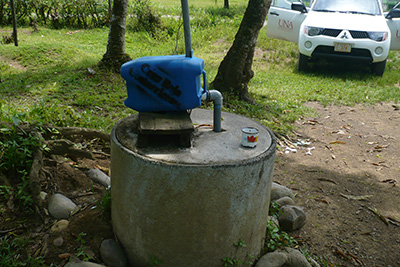

During August 2016, the results of the drinking water measurements conducted in 2011 as part of the activities of the ISA Program were published in the journal 'Environmental Pollution'. Below is a summary of the article in Spanish:
"Manganese concentrations in drinking water in villages near banana plantations with aerial spraying of mancozeb: Results from the Infants and Environmental Health Program (ISA)."
van Wendel de Joode B1, Barbeau B2, Bouchard MF3, Mora AM4, Skytt Å5, Córdoba L4, Quesada R4, Lundh T5, Lindh CH5, Mergler D6.
Environ Pollut. 2016 Aug;215:247-57. doi: https://doi.org/10.1016/j.envpol.2016.04.015 Epub 2016 May 19. PMID: 27208757
Summary:
Elevated concentrations of manganese (Mn) in drinking water have been reported worldwide. While naturally occurring manganese in groundwater is generally the main source, anthropogenic contamination caused by fungicides containing Mn such as mancozeb can also occur.
The main objective of this study was to examine the factors associated with Mn and ethylenethiourea (ETU), a degradation product of mancozeb, in samples of drinking water from communities located near banana plantations with aerial spraying of mancozeb. Drinking water samples (n = 126) were obtained from 124 households of women participating in the Infants and Environmental Health Program (ISA) who live near large-scale banana plantations. Concentrations of Mn, iron (Fe), arsenic (As), lead (Pb), cadmium (Cd), and ethylenethiourea (ETU), a degradation product of mancozeb, were measured in water samples.
Only six percent of the samples had detectable concentrations of ETU (limit of detection (LOD) = 0.15 mg/L), while 94% of the samples had detectable concentrations of Mn (LD = 0.05 mg/L). Mn concentrations were above 100 and 500 mg/L in 22% and 7% of the samples, respectively. Mn was higher in samples from private wells and banana plantation wells. The distance between the water source and the nearest banana plantation was inversely associated with Mn concentrations, with a 61.5% decrease (95% CI: -97.0, -26.0) in Mn concentrations for each kilometer increase in distance. Mn concentrations in water transported by tanker trucks from one village to another were nearly 1000 times higher than Mn in water obtained from taps in homes supplied by the same water source without being transported, indicating environmental contamination with Mn. Elevated Mn in drinking water can be partly explained by aerial spraying with mancozeb; however, naturally occurring Mn in groundwater and intensive agriculture can also contribute.
Risk assessment for mancozeb should consider Mn content in drinking water as a health hazard. The results of this study highlight the need for guidelines from the World Health Organization (WHO) regarding Mn content in drinking water.
Copyright © 2016 The Authors. Published by Elsevier Ltd. All rights reserved.
Article in English: http://10.0.96.35/isa/images/articulos/material_informativo/2016%20van%20Wendel%20de%20Joode%20et%20al%20Mn%20Water%20Aerial%20Spraying.pdf


